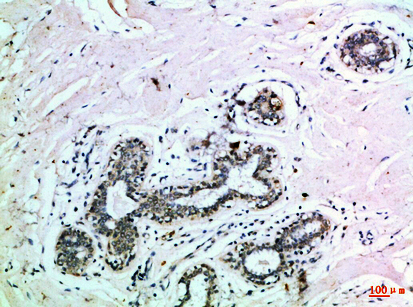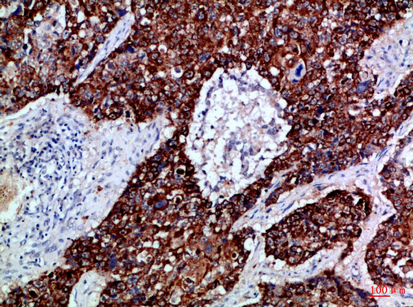EphB3 Polyclonal Antibody
- Catalog No.:YT6019
- Applications:IHC;IF;ELISA
- Reactivity:Human;Mouse;Rat
- Target:
- EphB3
- Fields:
- >>Axon guidance
- Gene Name:
- EPHB3 ETK2 HEK2 TYRO6
- Protein Name:
- Ephrin type-B receptor 3 (EC 2.7.10.1) (EPH-like tyrosine kinase 2) (EPH-like kinase 2) (Embryonic kinase 2) (EK2) (hEK2) (Tyrosine-protein kinase TYRO6)
- Human Gene Id:
- 2049
- Human Swiss Prot No:
- P54753
- Mouse Gene Id:
- 13845
- Mouse Swiss Prot No:
- P54754
- Immunogen:
- Synthetic peptide from human protein at AA range: 650-700
- Specificity:
- The antibody detects endogenous EphB3
- Formulation:
- Liquid in PBS containing 50% glycerol, 0.5% BSA and 0.02% sodium azide.
- Source:
- Polyclonal, Rabbit,IgG
- Dilution:
- IHC 1:50-200, ELISA 1:10000-20000. IF 1:50-200
- Purification:
- The antibody was affinity-purified from rabbit antiserum by affinity-chromatography using epitope-specific immunogen.
- Concentration:
- 1 mg/ml
- Storage Stability:
- -15°C to -25°C/1 year(Do not lower than -25°C)
- Other Name:
- Ephrin type-B receptor 3 (EC 2.7.10.1;EPH-like tyrosine kinase 2;EPH-like kinase 2;Embryonic kinase 2;EK2;hEK2;Tyrosine-protein kinase TYRO6)
- Background:
- Ephrin receptors and their ligands, the ephrins, mediate numerous developmental processes, particularly in the nervous system. Based on their structures and sequence relationships, ephrins are divided into the ephrin-A (EFNA) class, which are anchored to the membrane by a glycosylphosphatidylinositol linkage, and the ephrin-B (EFNB) class, which are transmembrane proteins. The Eph family of receptors are divided into two groups based on the similarity of their extracellular domain sequences and their affinities for binding ephrin-A and ephrin-B ligands. Ephrin receptors make up the largest subgroup of the receptor tyrosine kinase (RTK) family. This gene encodes a receptor for ephrin-B family members. [provided by RefSeq, Mar 2010],
- Function:
- catalytic activity:ATP + a [protein]-L-tyrosine = ADP + a [protein]-L-tyrosine phosphate.,function:Receptor for members of the ephrin-B family. Binds to ephrin-B1 and -B2.,similarity:Belongs to the protein kinase superfamily. Tyr protein kinase family. Ephrin receptor subfamily.,similarity:Contains 1 protein kinase domain.,similarity:Contains 1 SAM (sterile alpha motif) domain.,similarity:Contains 2 fibronectin type-III domains.,tissue specificity:Ubiquitous.,
- Subcellular Location:
- Cell membrane ; Single-pass type I membrane protein . Cell projection, dendrite .
- Expression:
- Ubiquitous.
- June 19-2018
- WESTERN IMMUNOBLOTTING PROTOCOL
- June 19-2018
- IMMUNOHISTOCHEMISTRY-PARAFFIN PROTOCOL
- June 19-2018
- IMMUNOFLUORESCENCE PROTOCOL
- September 08-2020
- FLOW-CYTOMEYRT-PROTOCOL
- May 20-2022
- Cell-Based ELISA│解您多样本WB检测之困扰
- July 13-2018
- CELL-BASED-ELISA-PROTOCOL-FOR-ACETYL-PROTEIN
- July 13-2018
- CELL-BASED-ELISA-PROTOCOL-FOR-PHOSPHO-PROTEIN
- July 13-2018
- Antibody-FAQs
- Products Images

- Immunohistochemical analysis of paraffin-embedded Human-breast, antibody was diluted at 1:100

- Immunohistochemical analysis of paraffin-embedded Human-lung-cancer, antibody was diluted at 1:100



